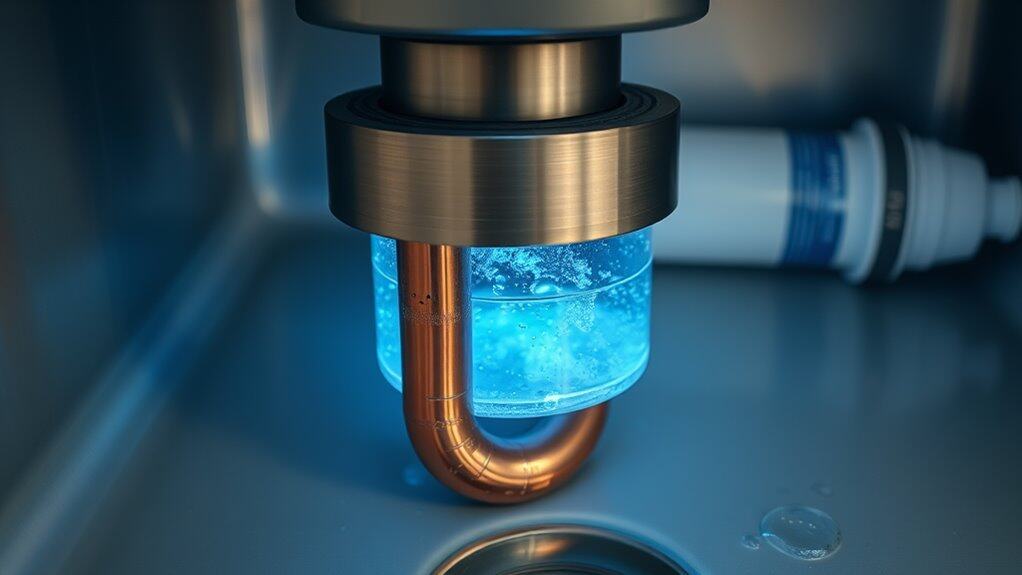Salt-free water conditioners using Template Assisted Crystallization (TAC) are disrupting the filtration industry. We’re seeing traditional companies panic as these systems prevent scale without salt, electricity, or wastewater generation. They transform calcium and magnesium into harmless micro-crystals while preserving beneficial minerals. With 90% scale reduction, minimal maintenance, and media replacement only every 5-15 years, they’re environmentally superior and cost-effective. The science behind this revolution challenges decades of established business models.
Key Takeaways
- Salt-free water conditioners using TAC technology prevent scale without removing beneficial minerals or requiring salt.
- Traditional filtration companies face disruption as consumers choose eco-friendly alternatives without recurring salt purchases.
- TAC technology transforms hard water minerals into harmless crystals while operating without electricity, chemicals, or waste.
- Salt-free systems reduce environmental impact by eliminating brine discharge and conserving thousands of gallons of water annually.
- Lower maintenance costs, extended appliance lifespans, and 5-15 year service lives make TAC conditioners increasingly attractive to consumers.
How Salt-Free Water Conditioners Disrupt the Status Quo
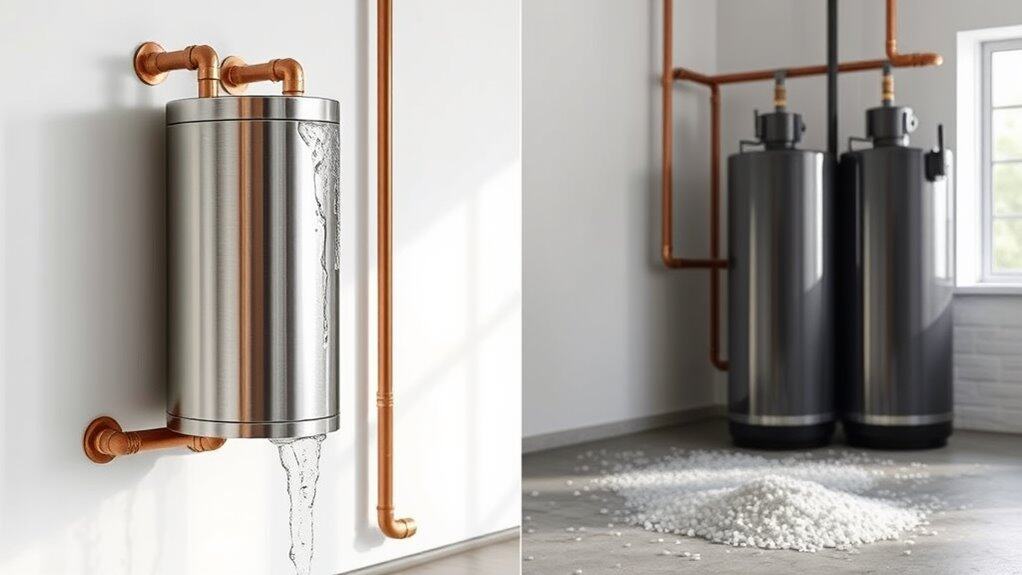
While traditional water softening companies have long dominated the market with salt-based systems, salt-free water conditioners are now triggering a significant paradigm shift in the industry.
Using innovative technologies like Template Assisted Crystallization, these systems prevent scale formation without removing beneficial minerals. This advanced method highlights the effectiveness of revolutionary water treatment that aligns with contemporary consumer needs.
Unlike conventional softeners, salt-free conditioners operate without electricity, chemicals, or wastewater generation—directly addressing environmental concerns about brine discharge.
Their maintenance-free operation eliminates recurring salt purchases, challenging established revenue models.
With a service life of up to 10 years, modern salt-free conditioners offer remarkable longevity compared to traditional systems that require frequent maintenance.
As regulations increasingly restrict salt discharge in wastewater, manufacturers must adapt.
The market’s evolution reflects consumers’ growing preference for sustainable solutions that maintain water quality without environmental compromise.
The Environmental and Cost Benefits Driving Consumer Shift
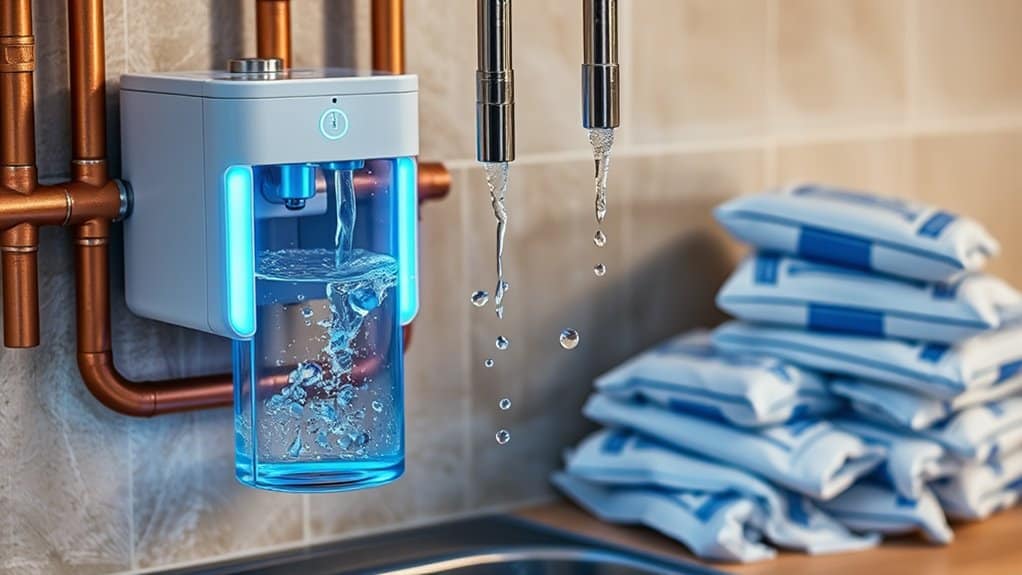
As environmental concerns intensify across global communities, salt-free water conditioners have emerged as a compelling alternative that addresses both ecological imperatives and financial considerations.
These systems eliminate salt discharge into waterways, protecting aquatic ecosystems while conserving significant water volumes by avoiding regeneration cycles. Additionally, these innovative systems provide maintenance-free operation that allows homeowners to enjoy soft water without the hassle of regular upkeep.
Simultaneously, consumers benefit from reduced energy consumption, lower operational costs, and extended appliance lifespans. Homeowners can realize significant savings as water softeners prevent mineral deposits that would otherwise reduce heating efficiency.
The market shift reflects growing sustainability demands, with consumers increasingly prioritizing eco-friendly solutions.
This transformation isn’t merely altruistic—households experience tangible benefits through decreased maintenance expenses, reduced chemical usage, and improved water quality, creating a compelling value proposition that traditional filtration companies struggle to counter.
Template-Assisted Crystallization: The Science Behind the Revolution
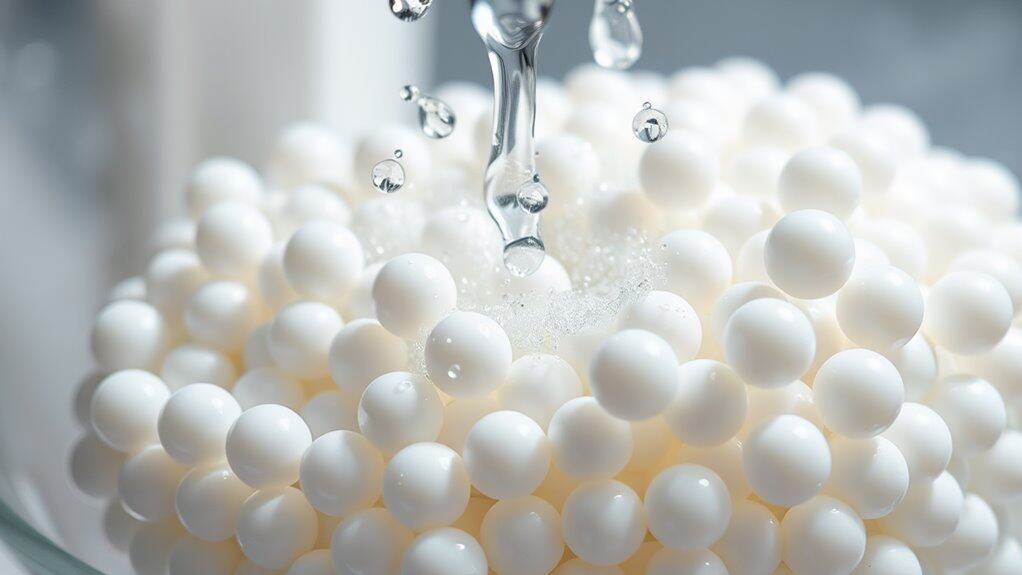
Template-Assisted Crystallization (TAC) represents a fundamental breakthrough in water treatment technology that has traditional filtration companies scrambling to adapt.
This elegant process utilizes specialized polymer beads with atomic-sized nucleation sites that transform calcium and magnesium ions into harmless suspended micro-crystals. This innovative method is particularly important because it enhances water conditioning efficiency, making it a game-changer in the industry.
Unlike conventional systems, TAC operates without electricity, chemicals, or wastewater production.
The science is compelling—microscopic crystals remain suspended in water rather than adhering to pipes.
Studies from Arizona State University confirm TAC reduces scale formation by over 90%, meeting rigorous German DVGW-W512 standards.
The system preserves beneficial minerals while requiring minimal maintenance with media replacement needed only every 5-15 years.
We’re witnessing a revolution backed by empirical data—environmentally sustainable technology that preserves mineral content while preventing costly scale buildup.
Real-World Performance: Comparing Water Conditioners to Traditional Softeners
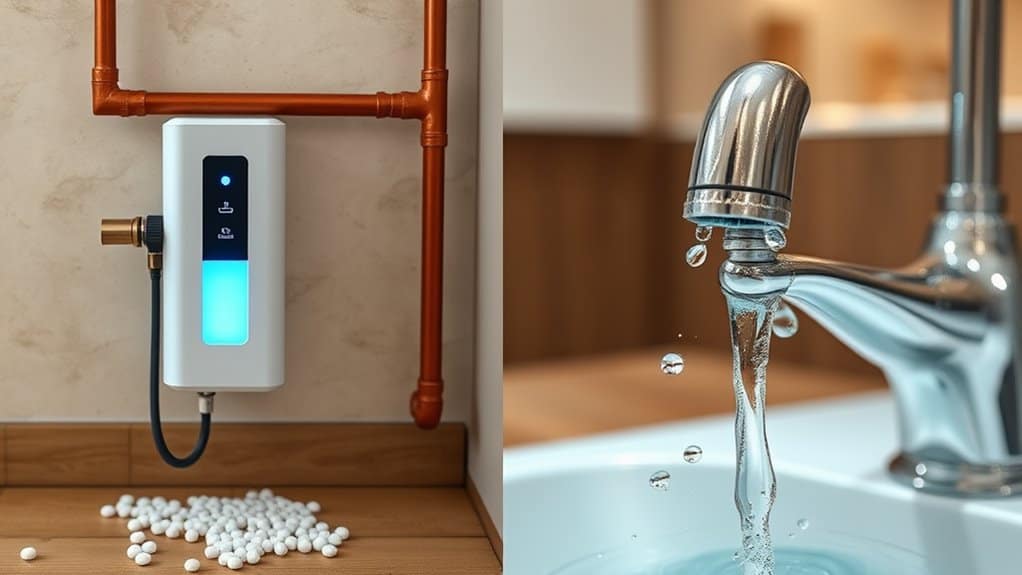
When homeowners evaluate water treatment options based on real-world performance metrics, the differences between modern water conditioners and traditional softeners become immediately apparent.
While softeners excel at mineral removal through ion exchange, they require regular salt replenishment, waste water during regeneration, and add sodium to your water.
Conditioners, by contrast, alter mineral structure without removing beneficial calcium and magnesium. Salt-free conditioners are particularly beneficial in areas with brine restrictions where traditional water softening systems might face limitations. Many homeowners have discovered that they can save big with alternative water softener choices by opting for these innovative solutions.
We’ve found conditioners offer compelling advantages: lower maintenance requirements, reduced environmental impact, no sodium addition, and often lower operating costs.
Though they may not match softeners’ effectiveness for severe hardness, their ability to prevent scaling while addressing biofilm and chlorine makes them increasingly attractive for environmentally-conscious households.
Frequently Asked Questions
How Long Do Water Conditioner Media Cartridges Typically Last Before Replacement?
We’ve analyzed that water conditioner media cartridges typically last 1-15 years, depending on media type, water quality, usage frequency, and system design. Resins endure longest while pitcher filters need frequent replacement.
Can Water Conditioners Effectively Treat Extremely Hard Water (>15 Gpg)?
While water conditioners using TAC technology can treat extremely hard water, we’ve found they’re typically less effective than traditional softeners at levels >15 gpg, where ion exchange remains our preferred solution for complete hardness removal.
Will Water Conditioners Remove Existing Scale Buildup in Old Pipes?
We find most water conditioners ineffective at removing existing scale buildup in old pipes. They primarily prevent new scale formation, while established mineral deposits typically require active descaling methods or mechanical intervention.
Do Water Conditioners Affect Beneficial Minerals in Drinking Water?
We preserve beneficial minerals in your drinking water through our conditioning processes. Unlike softeners, our systems modify mineral structures to prevent scaling while maintaining calcium and magnesium’s nutritional availability in your water supply.
Are Water Conditioners Compatible With Well Water Containing Iron?
We’ve observed that standard water conditioners aren’t optimally compatible with iron-rich well water. They require supplementary iron filtration systems like AIO technology to maintain effectiveness and prevent mineral fouling of the conditioning media.
Conclusion
We’ve examined how template-assisted crystallization technology delivers effective scale prevention without salt, chemicals, or wastewater. This innovation presents a significant environmental advantage by eliminating brine discharge while reducing maintenance requirements and operating costs. As water conservation becomes increasingly critical, these conditioners represent a sustainable alternative that challenges traditional softening paradigms. Their growing market share demonstrates that efficiency and environmental responsibility can successfully converge in water treatment solutions.
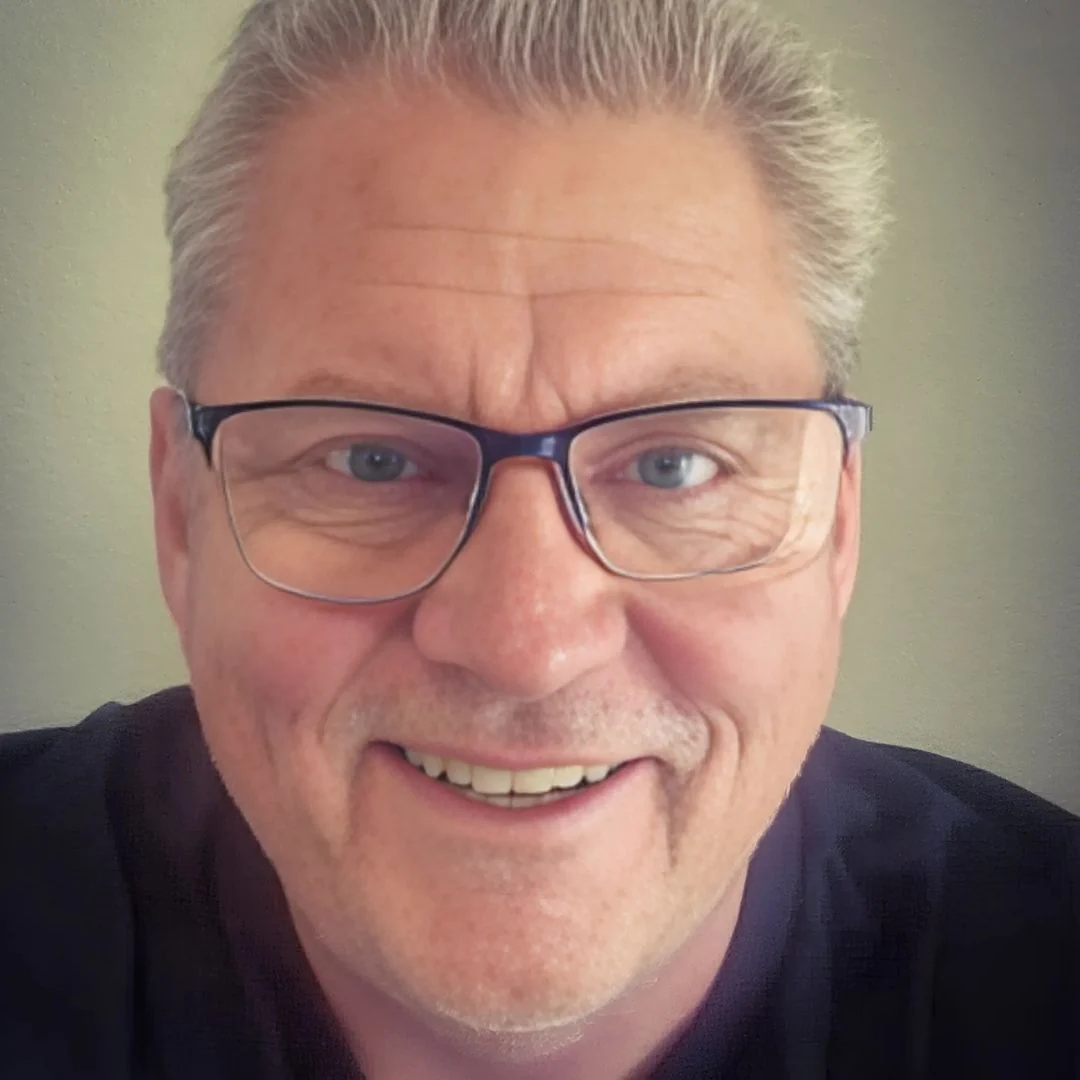
Craig “The Water Guy” Phillips is the founder of Quality Water Treatment (QWT) and creator of SoftPro Water Systems.
With over 30 years of experience, Craig has transformed the water treatment industry through his commitment to honest solutions, innovative technology, and customer education.
Known for rejecting high-pressure sales tactics in favor of a consultative approach, Craig leads a family-owned business that serves thousands of households nationwide.
Craig continues to drive innovation in water treatment while maintaining his mission of “transforming water for the betterment of humanity” through transparent pricing, comprehensive customer support, and genuine expertise.
When not developing new water treatment solutions, Craig creates educational content to help homeowners make informed decisions about their water quality.


